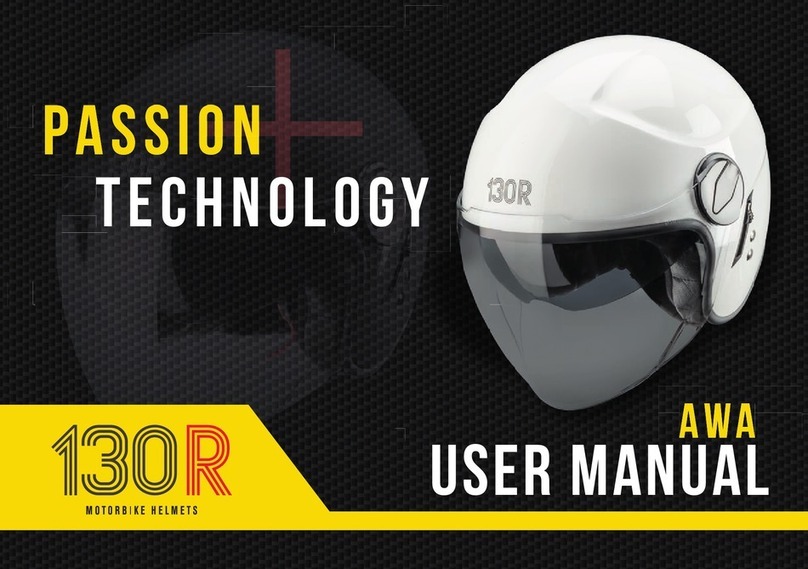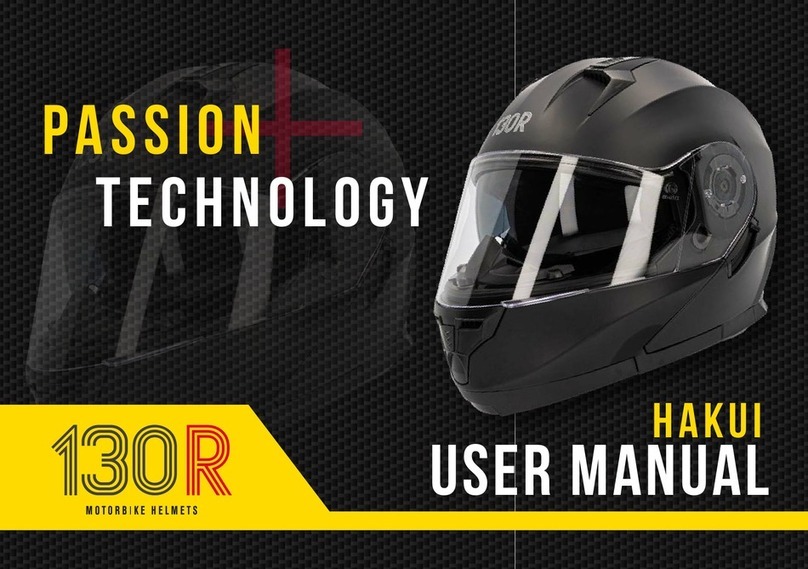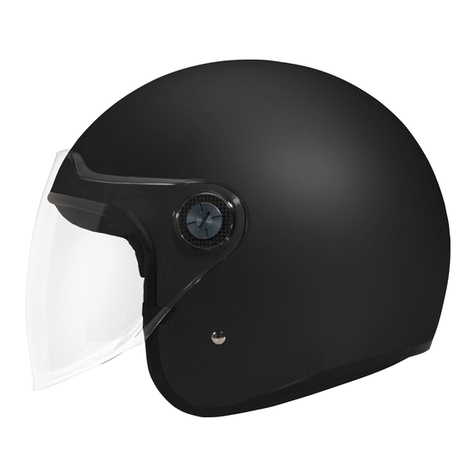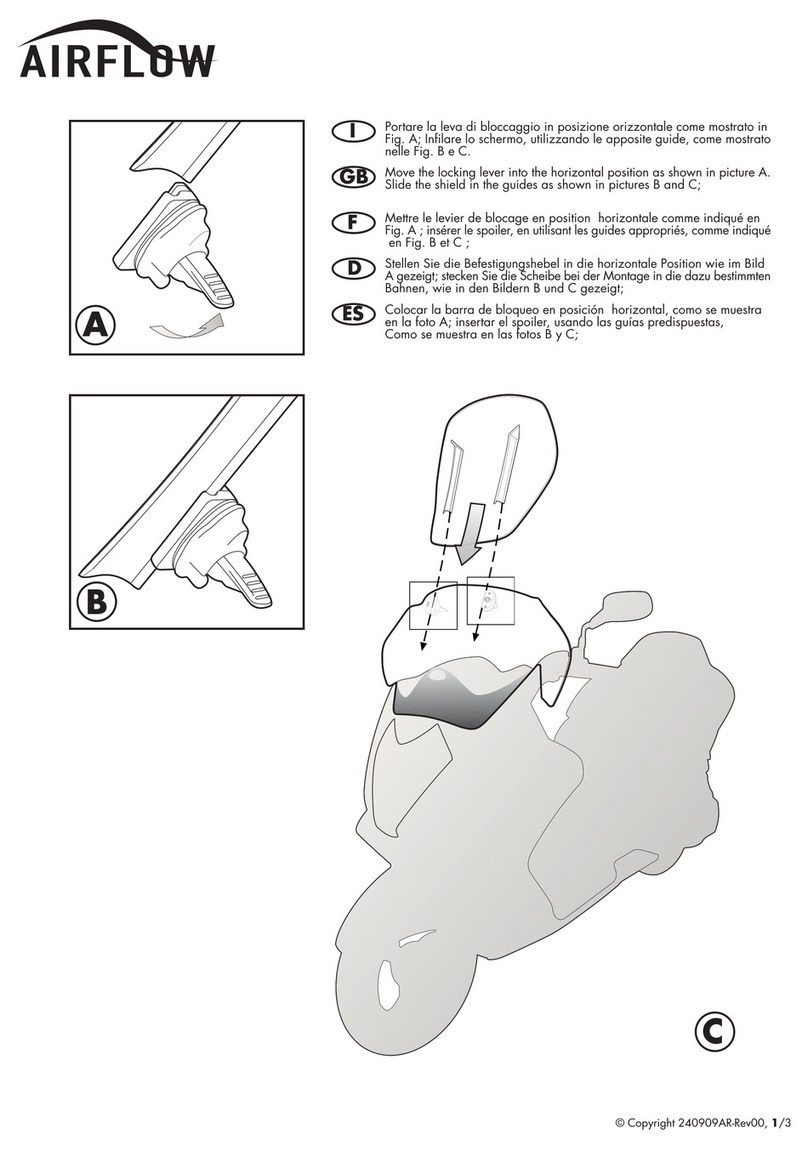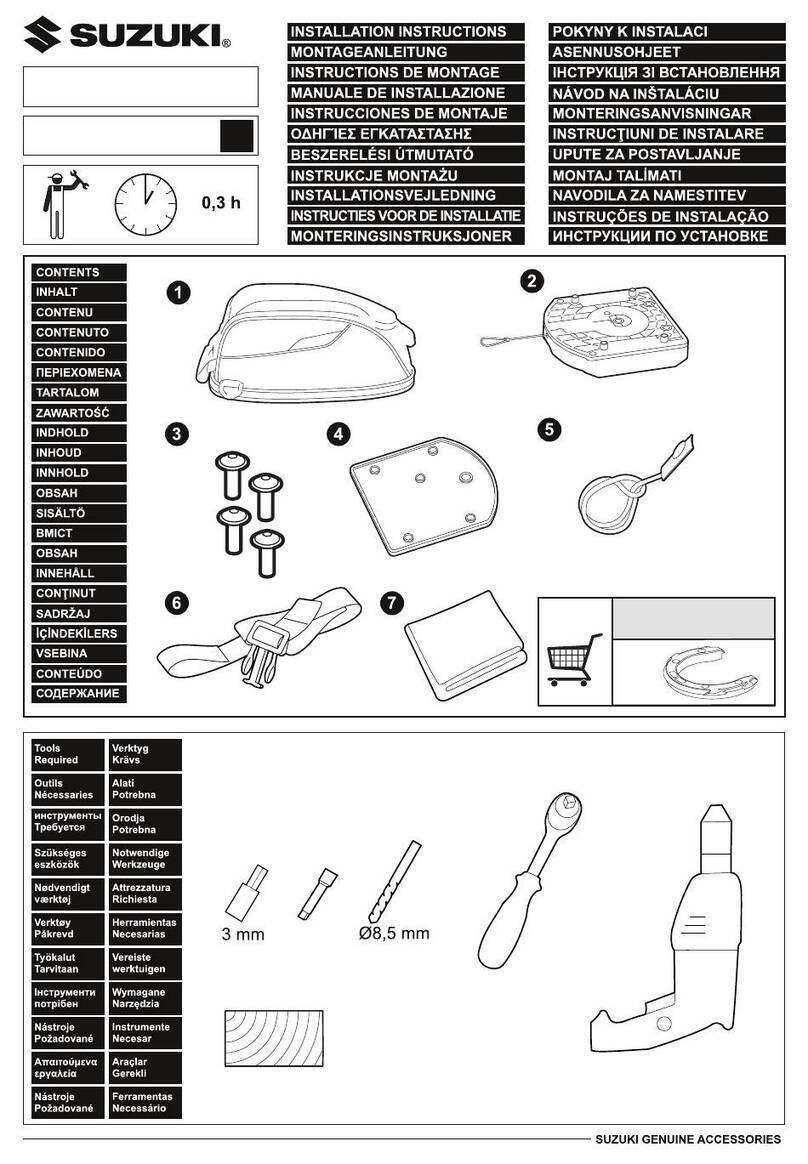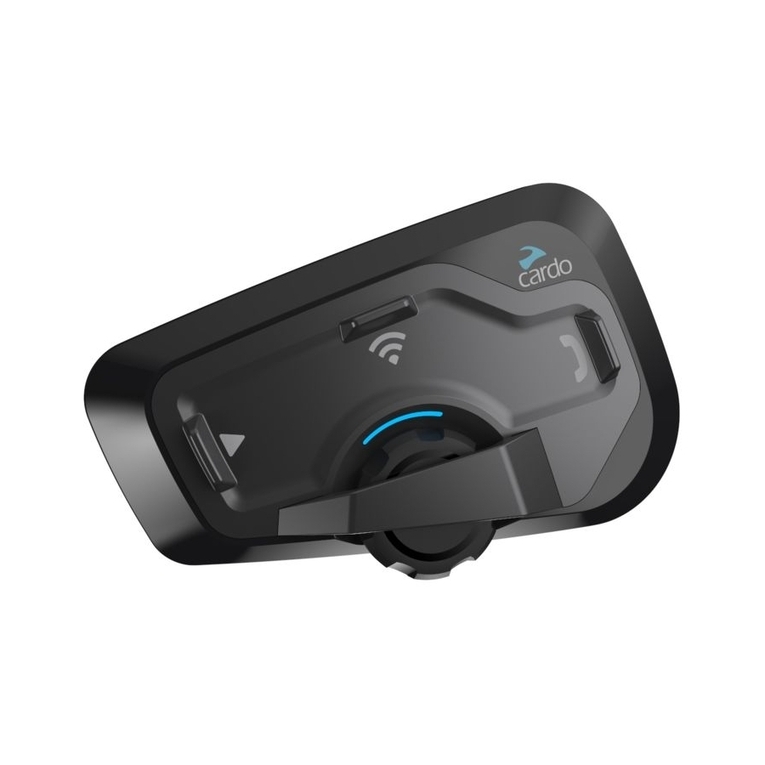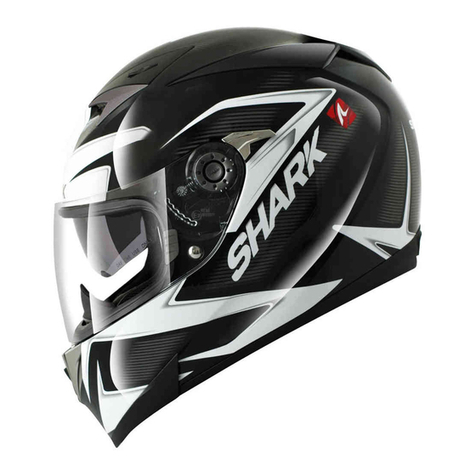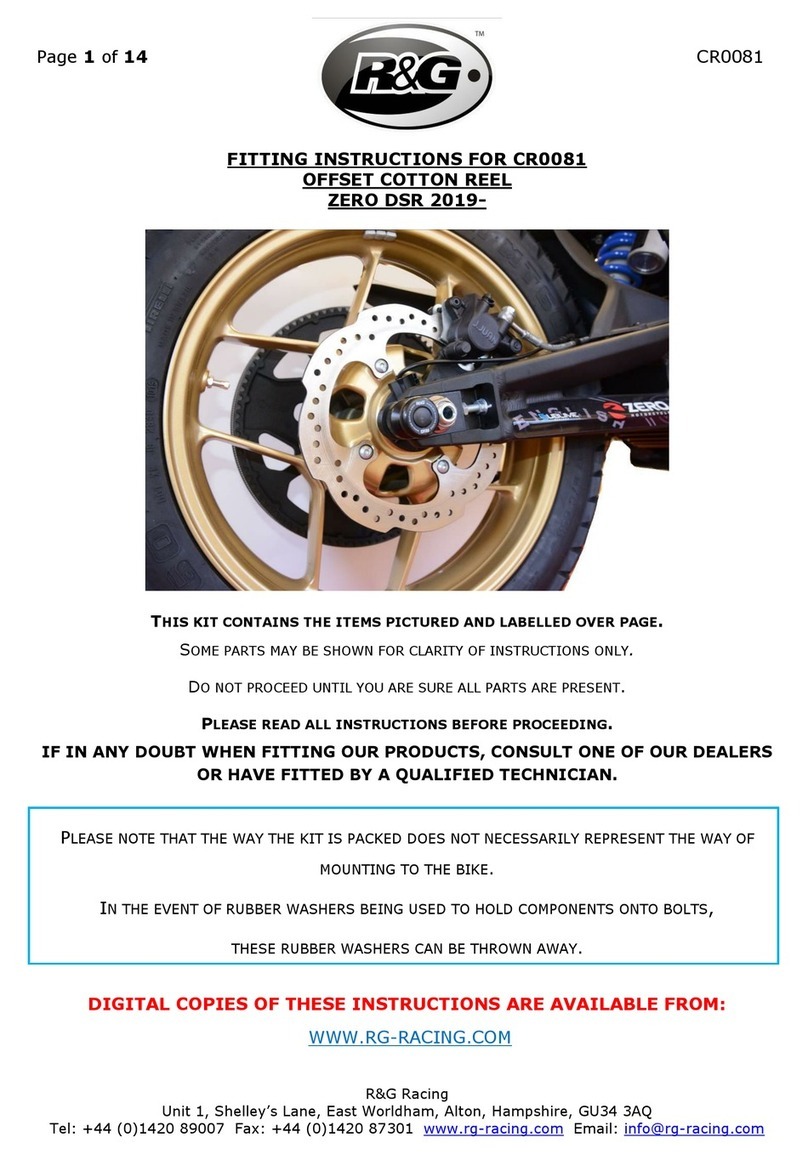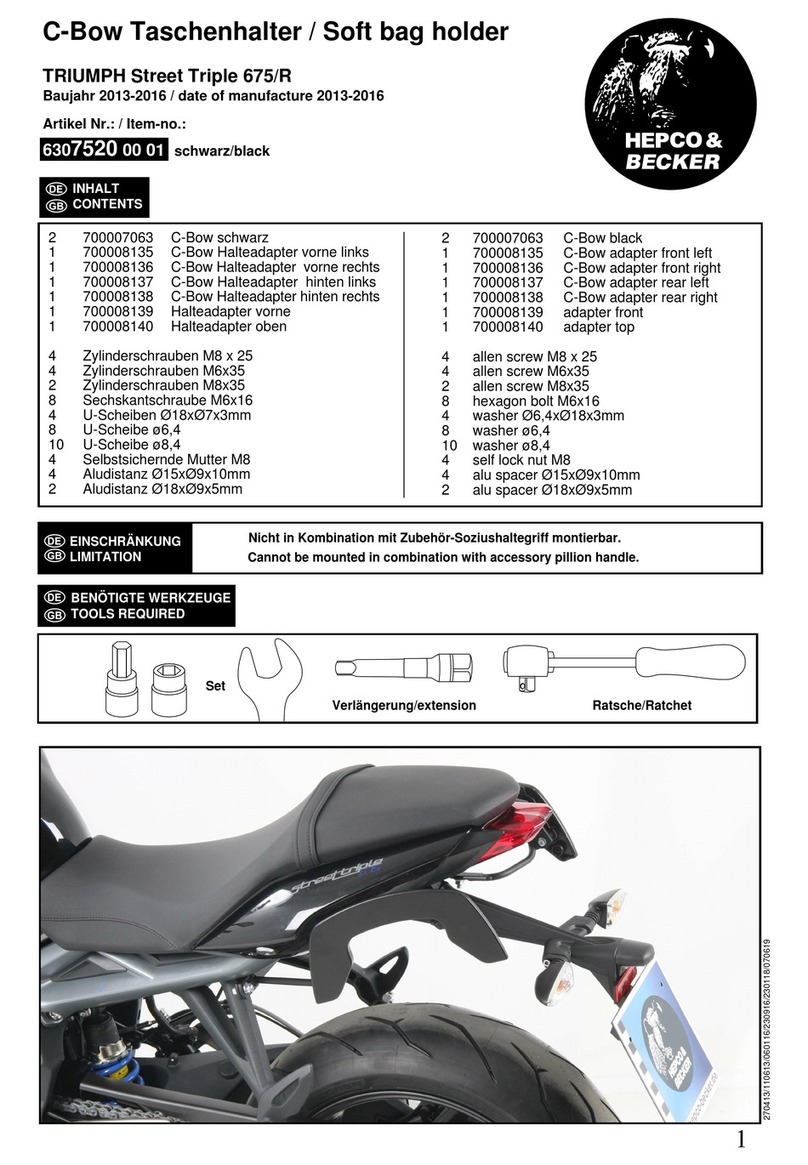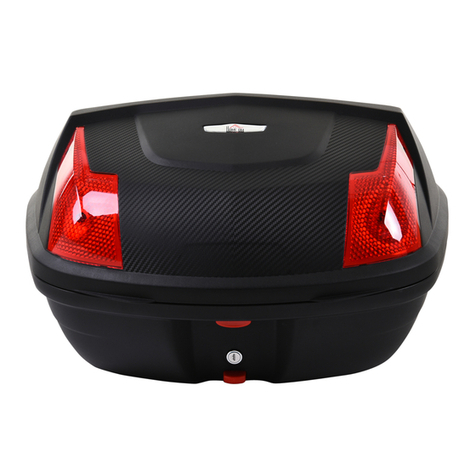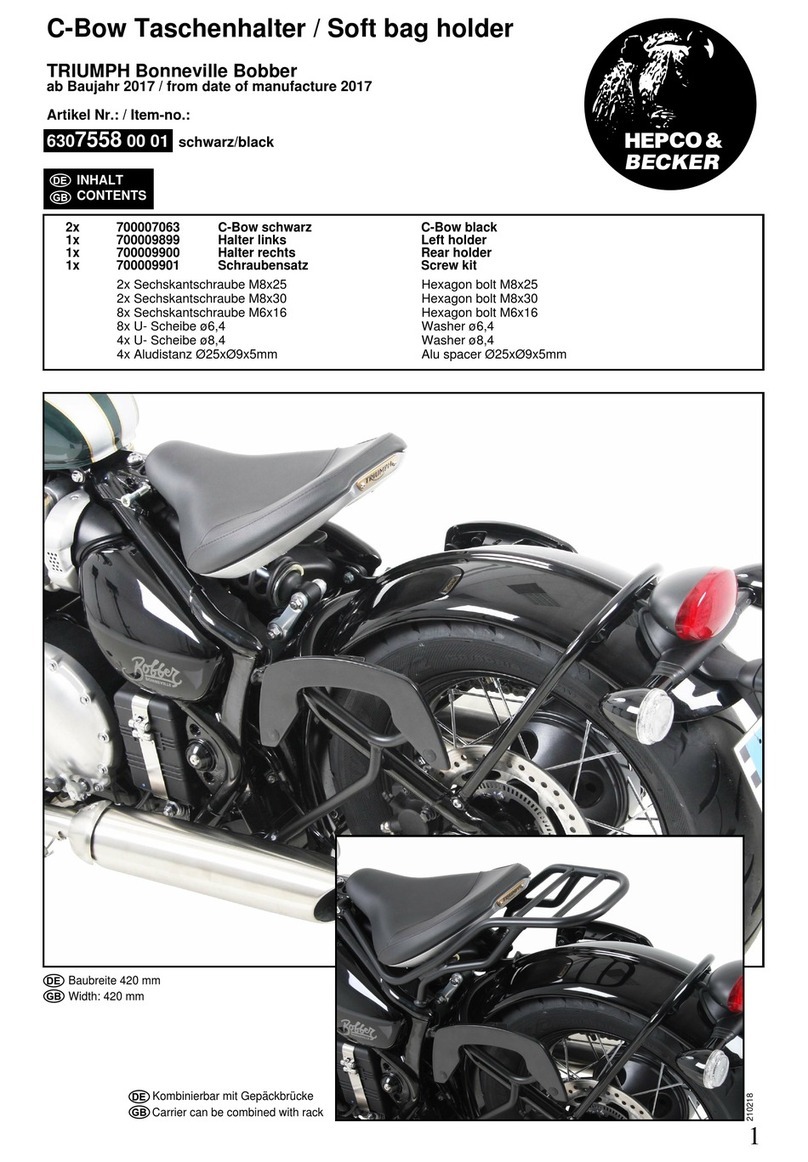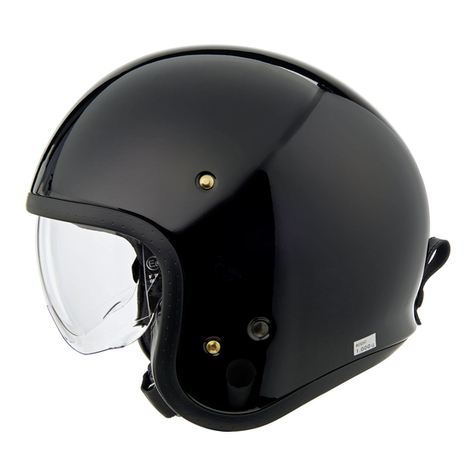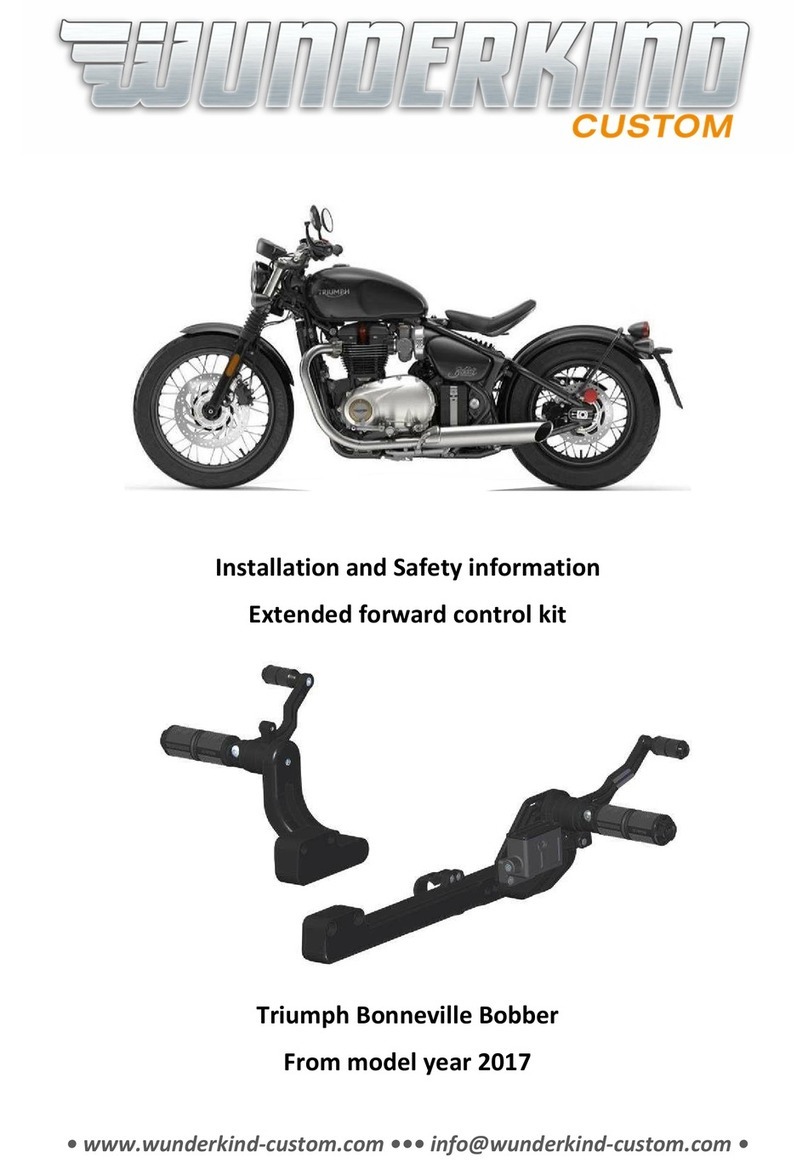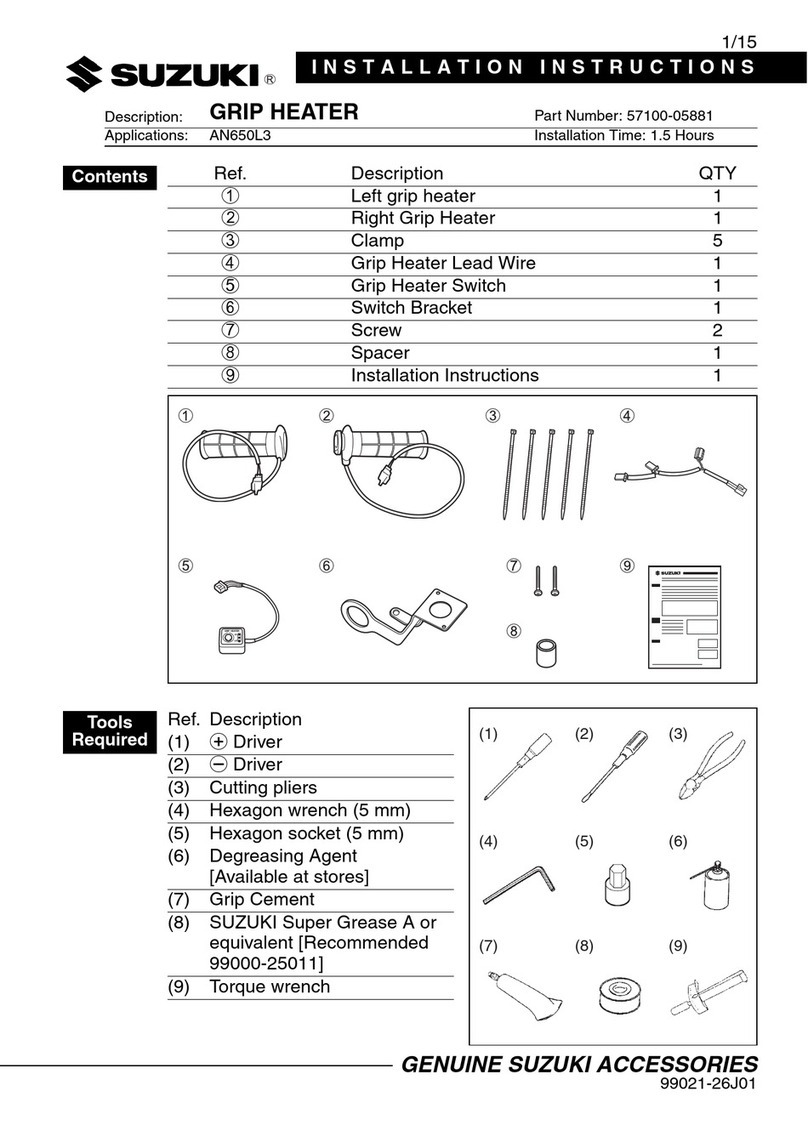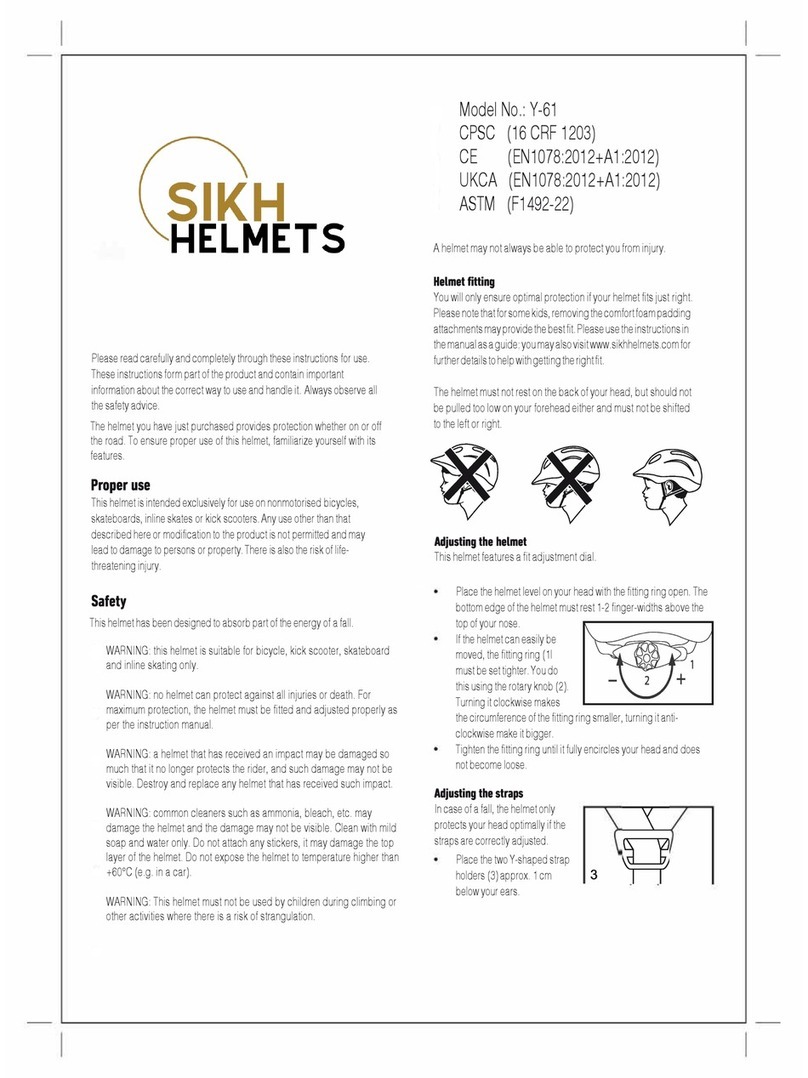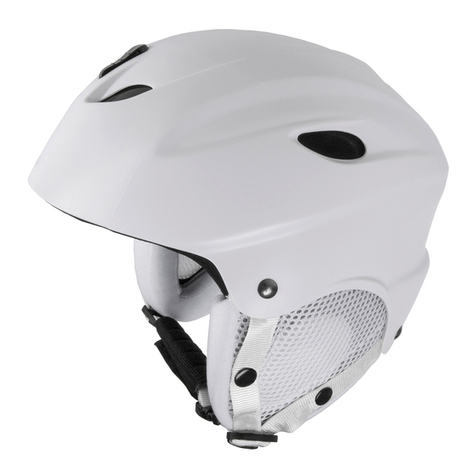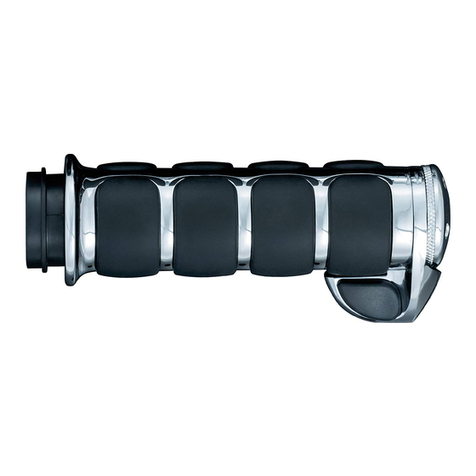130R ARIDA User manual

+
PASSIOn
technology
user manual
ARIDA

2
index
ENGLISH 3-10
CASTELLANO 11-18
FRANÇAIS 19-26
ITALIANO 27-34
DEUTSCH 35-42
PORTUGUÊS 43-50

user manual
We thank you for choosing your new 130R helmet. Please read the
indications and instructions in this manual before using your new 130R helmet.
This user manual contains instructions for use and care that will help you
achieve maximum protection and correct conservation of your 130R helmet.
For all our helmets, we place the combination of innovation and technique 4
acquired during so many years dedicated to the world of the motorcycle
at your service.
All 130R helmets are designed and conceived in Barcelona, a city with
a long motorcycling tradition, our helmets bring together the passion we
feel for the motorcycle.
And, of course, the safety of the rider is foremost. Because it’s always rst.
Without concessions.
EN
ES
FR
IT
DE
PT
3
To choose your size correctly, with a tape measure (or a cord that you can then
measure) measure the contour of your head about 2.5cm above your eyebrows,
to get the maximum circumference of your head.
sizes
SIZE
XS 52 / 53
S 54 / 55
M 56 / 57
L 58 / 59
XL 60 / 61
CIRCUMFERENCE (CM)
ARIDA

EN
ES
FR
IT
DE
PT
4
choose your size
fit
try on the helmet
1. To choose your size correctly, with a tape measure (or a cord that you can then
measure) measure the contour of your head about 2.5cm above your eyebrows, to get
the maximum circumference of your head.
2. Choose the helmet that best suits the size of your head. If you have doubts between
two sizes, choose the smaller of them.
1. To put on the helmet, open it by holding both ends of the closure straps. In this way
you’ll facilitate placing the helmet on the head.
2. The helmet should be tight, but it should not cut off the circulation or be painful. Once
it’s on, if it isn’t tight, then it's too big for you. In that case, use a smaller size, even if it is
more difcult to put on.
3. You must make sure that there is no free space between your nape and the helmet and
that your cheeks are in contact with the side pads.
4. With the helmet on and without moving the head, grab the helmet on each side and
move it laterally and up and down. If you can move it easily, the helmet is too large and
you must choose a smaller size.
retention system
warning
1. Once the helmet is on, tighten the retention system. You should tighten it as much as
possible, but without causing pain.
2. When tightened, try to remove the helmet by pushing forward with your hands from
the back. If the helmet comes off, then the helmet is too large or the retention system is
not tight enough.
3. Repeat the previous operation, but placing your hands on the front of the helmet and
pushing back. If the helmet comes off, then the helmet is too large or the retention system
is not tight enough.
4. The strap of the retention system should be tight against your chin once closed. If not,
you should adjust the tightness correctly.
You must wear the helmet fastened at all times. Having the retention system loose or
unfastened can cause the helmet to fail to fulll its protective function, causing serious
injury or death in the event of impact or accident. Please, always wear this helmet
correctly tied with your retention system.
Never adjust your helmet whilst riding, you must always do so when stopped.

EN
ES
FR
IT
DE
PT
5
helmet parts
EN
ES
FR
IT
DE
PT
12
3
4
8
5
6
1. THERMOPLASTIC OUTER SHELL
2. INNER SHELL EPS
3. SCREEN
4. SCREEN MECHANISM
5. SOLAR VISOR
6. SOLAR VISOR OPERATION
7. IN AIR VENT WITH REGULATOR
8. REMOVABLE INTERIOR
7

EN
ES
FR
IT
DE
PT
6
warning
You must wear the helmet fastened at all times. Having the retention system loose or
unfastened can cause the helmet to fail to fulll its protective function, causing serious
injury or death in the event of impact or accident. Please, always wear this helmet
correctly closed with your retention system.
retention system
micrometric
To close or open the micrometric retention system, hold the clip and insert or
remove the striated metal part into the retention system.
To adjust the retention to your chin, pull the fastening tape as indicated in the
graphic so that it passes through the ring.

Removable
inner crown Removable side pads Hand wash Cold
Water Air dry
recommendations
NO HELMET CAN PROTECT YOU ALWAYS
AFTER AN IMPACT
No helmet can protect you from all possible accidents or impacts, whether at high or
low speed. But to get as much protection as possible, the helmet should be as tight as
possible against your head, tied correctly under your chin.
If the helmet is too large for you, it can move when riding your motorcycle, interfering
with vision, or come off in the event of an accident, failing to protect you and can
cause serious injury or death.
For your safety, this helmet meets or exceeds the approved ECE 22.05 standard. Tests
include energy attenuation, penetration resistance, structural integrity of the chin strap
and labeling requirements for road motorcycle helmets.
After an accident or impact, discard this helmet and replace it with a new one.
This helmet has been designed such that in the event of an accident, the energy of the
impact is distributed throughout the maximum possible area, minimizing the damage
to your head.
Although no damage may be appreciated externally, the materials inside have fullled
their function and have become compacted after absorbing the energy of the impact
and this helmet now has no capacity to absorb again. In this case, it will not protect
you in the event of a new accident or impact.
cleaning
EN
ES
FR
IT
DE
PT
7
Never use hot water or water with salt, petrol, diesel, crystal cleaners or solvents of any
kind to clean this helmet. Even though externally you cannot see it, this helmet can be
damaged by the use of corrosive or chemical substances.
A helmet deteriorated due to incorrect cleaning cannot protect you in the case of impact
or accident.
To clean the helmet correctly, use only water or mix some drops of neutral detergent in
half a liter of warm water. Use a smooth damp cloth or a microber cloth with the soapy
water and gently clean the helmet and the screen, concentrating on the parts that need
it most. Dry off with other smooth cloth or absorbent paper.
washing the inner
Although the interiors of your helmet have an antibacterial treatment, they are removable
and washable when needed. Please, preferably hand wash and with cold water using
a neutral detergent and leaving them to air dry. Do not use a dryer In the case of bad
odors or dirt, wash the interiors as indicated.
We do not recommend the use of spray cleaners or similar, they could damage the
interior or not be effective enough.

EN
ES
FR
IT
DE
PT
8
modifications
Never modify your helmet, including making holes or cuts either in the shell, inside or the
screen of the helmet. Don't modify the retention system either. Modifying the helmet could
cause it to not perform its function properly in the event of an accident or impact and
cause severe injury or death.
Always use original 130R spare parts and accessories for screens, mechanisms, visors,
screws or for other parts.
Also, do not repaint or place stickers on your helmet, since the paint or some types of
adhesives can weaken or spoil the materials of your helmet.
TREAT YOUR HELMET WELL
Use this helmet correctly fastened on your head. When not in use, take it and always
keep it in its bag. Do not leave it directly on the ground or hang it anywhere (nail
on the wall, rear-view mirror...).
Don't leave your helmet in direct sunlight or close to heat sources, such as radiators or
your motorcycle engine. Do not use chemical cleaners or agents.
Avoid hitting the helmet or letting it fall, always keep it in a dry and safe place. Do not
leave your helmet on your bike or hanging from the rear-view mirror, it could fall and
get damaged.
screen
This helmet contains a clear high-impact polycarbonate screen that will protect you in
case of impact or accident. Always keep it clean without affecting vision through the
screen. Although it has an anti-scratch treatment, you must avoid scratches.
In the case of deep scratches that will affect vision, change the screen for a new one as
it will affect your riding, especially at night.
This screen has an anti-fog treatment, but in case of fogging do not ride your motorcycle.
It is very dangerous to ride with the screen misted up.
Clean the screen with water or soapy water with a smooth damp cloth and making
gentle, sideways movements. Concentrate on the dirt if necessary. Dry with a gentle
cloth or absorbent paper. Never use adhesives or chemical substances or cleaners on
the screen. If your helmet does not have a screen, always use homologated protective
goggles for motorcycle riding.
+
To change the screen:
1. Raise the screen to the highest position.
2. Move the button towards the back of the
helmet. The tab frees the screen.
3. Remove the screen from the mechanism.
4. Drop the button.
To place the screen repeat the process
backwards.

EN
ES
FR
IT
DE
PT
9
SOLAR VISOR
This helmet has a sun visor, use it only during the day and without it affecting your
vision. Remember that it has a darkening that prevents glare in daytime riding in the
sun but that can cause vision to be reduced under different atmospheric conditions.
Do not use it at night or in low visibility conditions.
If you use a screen other than the transparent one, follow the same recommendations.
Do not use screens that are not compatible with your 130R helmet.
Solar visor operation

EN
ES
FR
IT
DE
PT
10
exterior perception
check your helmet
With the helmet on, the perception of exterior sound and noise is mufed and changes.
Remember that the sound of trafc will be different with the helmet on, especially at high
speed. In any case, always ride with the screen down and closed in your helmet or, if
you do not have one, with protective goggles.
The opening or closing of the helmet ventilations if you have them will also inuence the
perception of the exterior sound, as well as if you ride with the screen open.
The use of internal speakers or intercom systems will also affect external perception,
keep this in mind.
This 130R helmet has been designed and manufactured to offer you the maximum
possible protection. However, some materials could be affected by the passage of time.
It is recommended that you change your helmet every 3-5 years. In case any component
has deteriorated, replace it or get a new one.
In each use, check that the safety system is tight and that the side and central pads are
securely fastened, as well as that the visibility is correct for all angles, both laterally and
vertically.
All 130R helmets have a minimum warranty of 1 year from the date of purchase, due to
defects in their materials or manufacture, or because of the legal warranty period
depending on the country of purchase. This warranty covers both materials and labor.
It does not cover helmets that have suffered an accident, impact or that have not followed
the care or maintenance indicated in this manual. It also does not cover misuse, negligence
or if the product has been tampered with.
Fluorescent paints or graphics are also not covered by this warranty, as they may become
discolored over time and/or due to exposure of the helmet to the weather or sunlight.
If there is any issue or doubt, please contact your seller or 130R after-sales service
attaching the purchase ticket at:
130r motorbike helmets
warranty

MANUAL DE USUARIO
Te damos las gracias por la elección de tu nuevo casco 130R.
Por favor, lee las indicaciones e instrucciones de este manual
antes del uso de tu nuevo casco 130R.
Este manual de usuario contiene instrucciones de uso y cuidado
que te ayudarán a conseguir la máxima protección de tu casco
130R y su correcta conservación.
En todos nuestros cascos ponemos a tu servicio la combinación
de innovación y técnica adquirida durante tantos años dedicados
al mundo de la motocicleta.
Todos los cascos 130R están diseñados y concebidos en Barcelona,
ciudad de larga tradición motociclista, nuestros cascos reúnen la
pasión con la que sentimos la moto.
Y por supuesto la seguridad del motorista como bandera. Porque es
siempre lo primero. Sin concesiones.
EN
ES
FR
IT
DE
PT
11
Para elegir correctamente tu talla, mide con cinta métrica (o una cuerda que
luego puedas medir) el contorno de tu cabeza a unos 2,5cm por encima de
tus cejas, para obtener la circunferencia máxima de tu cabeza.
tallas
10
TALLA
XS 52 / 53
S 54 / 55
M 56 / 57
L 58 / 59
XL 60 / 61
CIRCUNFERENCIA (CM)
ARIDA

EN
ES
FR
IT
DE
PT
12
elegir tu talla
ajuste
pruébate el casco
1. Para elegir correctamente tu talla, mide con cinta métrica (o una cuerda que
luego puedas medir) el contorno de tu cabeza a unos 2,5cm por encima de
tus cejas, para obtener la circunferencia máxima de tu cabeza.
2. Elige el casco que mejor se adapte a la talla de tu cabeza. Si tienes dudas
entre dos tallas, elije la más pequeña de entre ambas.
1. Para colocarte el casco, ábrelo sujetando ambos extremos de las cintas del abroche
del cierre. Facilitarás la entrada del casco en la cabeza de esta forma.
2. El casco debe apretarte, pero no debe cortar la circulación ni debe ser doloroso.
Si una vez puesto no te aprieta, entonces te queda grande. En ese caso, usa una talla
inferior, aunque te resulte más difícil de colocar.
3. Debes de estar seguro de que no haya espacio libre entre tu nuca y el casco y que tus
mejillas estén en contacto con las almohadillas laterales.
4. Con el casco puesto y sin mover la cabeza, agarra el casco por cada lateral
y muévelo lateralmente y hacia arriba y abajo. Si lo mueves con facilidad, el casco
es demasiado grande y debes elegir una talla más pequeña.
sistema de cierre
1. Una vez puesto el casco, aprieta el sistema de cierre. Debe cerrar lo máximo
posible, pero sin causar dolor.
2. Una vez apretado, trata de quitarte el casco empujando hacia delante con tus
manos desde la parte trasera. Si el casco se sale, es que el casco es demasiado
grande o el sistema de cierre no está lo sucientemente apretado.
3. Repite la operación anterior, pero colocando tus manos en el frontal del casco
y empujando hacia atrás. Si el casco se sale, es que el casco es demasiado
grande o el sistema de cierre no está lo sucientemente apretado.
4. La cinta del sistema de cierre debe quedar pegada a tu barbilla una vez cerrado.
Si no es así, debes ajustar su apriete correctamente.
atención
Debes llevar abrochado el casco en todo momento. Llevar el sistema de cierre ojo,
suelto o sin abrochar puede hacer que el casco deje de cumplir su función de
protección, provocando graves lesiones o la muerte en caso de impacto o accidente.
Por favor, lleva siempre este casco bien atado con su sistema de cierre.
Nunca ajustes tu casco durante la conducción, debes hacerlo siempre en parado.

PARTES DEL CASCO
1 3
12
3
4
8
5
6
1. CALOTA EXTERIOR RESINA TERMOPLÁSTICA
2. CALOTA INTERIOR EPS
3. PANTALLA
4. MECANISMO DE PANTALLA
5. VISOR SOLAR
6. ACCIONAMIENTO VISOR SOLAR
7. ENTRADA DE AIRE CON REGULADOR
8. INTERIOR EXTRAÍBLE
7

micrométrico
Para cerrar o abrir el sistema de cierre micrométrico, mantén sujeto el clip
e introduce o extrae la pieza metálica estriada en el sistema de cierre.
Para ajustar el cierre a tu barbilla, tira de la cinta de sujección como se
indica en el gráco para que pase a través de la anilla.
SISTEMA DE cierre
EN
ES
FR
IT
DE
PT
1 4
atención
Debes llevar abrochado el casco en todo momento. Llevar el sistema de cierre ojo,
suelto o sin abrochar puede hacer que el casco deje de cumplir su función de
protección, provocando graves lesiones o la muerte en caso de impacto o accidente.
Por favor, lleva siempre este casco bien atado con su sistema de cierre.
Nunca ajustes tu casco durante la conducción, debes hacerlo siempre en parado.

recomendaciones
ningún casco protege siempre
tras un impacto
Ningún casco puede protegerte ante todos los posibles accidentes o impactos,
ya sean a alta o baja velocidad. Pero para obtener la máxima protección posible,
el casco debe ir lo más ajustado posible a tu cabeza, atado correctamente por
debajo de tu barbilla.
Si el casco te va grande, puede moverse al conducir tu motocicleta interriendo
en la visión o salirse en caso de accidente, dejando de protegerte y pudiendo
provocar una grave lesión o la muerte.
Para tu seguridad, este casco cumple o supera la norma ECE 22.05 aprobada.
Las pruebas incluyen la atenuación de la energía, la resistencia a la penetración,
la integridad estructural de la correa de la barbilla y los requisitos de etiquetado
para los cascos de motocicleta de carretera.
Tras un accidente o impacto, desecha este casco y sustitúyelo por uno nuevo.
Este casco ha sido diseñado para que en caso de accidente se distribuya la energía
del impacto en el máximo área posible, minimizando los daños en tu cabeza.
Aunque no se aprecien daños exteriormente, los materiales de su interior han
cumplido su función y han quedado compactados tras absorver la energía del
impacto y este casco ya no tiene la capacidad de volver a absorverlo de nuevo.
En este caso, no te protegerá en caso de un nuevo accidente o impacto.
limpieza
EN
ES
FR
IT
DE
PT
1 5
Nunca utilices agua caliente o agua con sal, gasolina, gasoil, limpiadores de cristales
o disolvente de cualquier tipo para limpiar este casco. Aunque externamente no pueda
apreciarse, este casco podría dañarse al utilizar sustancias corrosivas o químicas.
Un casco deteriodado por una mala limpieza, podría no protegerte en caso de
impacto o accidente.
Para limpiar el casco correctamente, utiliza solo agua o bien mezcla algunas gotas
de jabón neutro en medio litro de agua tibia. Utiliza un paño húmedo suave o de
microbras dentro de la mezcla jabonosa y limpia el casco y la pantalla suavemente
incidiendo en las partes de lo necesiten. Seca con otro paño suave o papel
absorvente.
lavado del interior
Aunque los interiores de tu casco tienen un tratamiento antibacteriano, son extraíbles y
lavables cuando se necesite. Por favor, lávalos preferiblemente a mano y con agua fría,
utilizando un jabón neutro y dejándolos secar al aire. No utilices secadora.
En caso de malos olores o suciedad, lava los interiores de la forma indicada.
No recomendamos el uso de limpiadores en spray o similares, podrían dañar el interior
o bien no ser lo sucientemente efectivos.
Interior extraíble Almohadillas laterales
extraíbles Agua fría Secar
al aire
Lavado
a mano

modificaciones
Nunca hagas modicaciones a tu casco, incluyendo hacer agujeros o cortes ya sean en
la calota, el interior o la pantalla del casco. Tampoco modiques el sistema de cierre.
Modicar el casco podría hacer que no cumpla su función correctamente en caso de
accidente o impacto y provocar fuertes lesiones o la muerte.
Utiliza siempre recambios y accesorios 130R originales tanto para las pantallas,
mecanismos, viseras, tornillos o para otras piezas.
Tampoco repintes o pongas adhesivos en tu casco, ya que la pintura o algunos tipos de
adhesivos pueden debilitar o estropear los materiales de tu casco.
trata bien tu casco
Utiliza correctamente este casco abrochado en tu cabeza. Cuando no lo uses
llévalo y guárdalo siempre en su bolsa. No lo dejes directamente sobre el suelo
ni lo cuelgues en cualquier sitio(clavo de una pared, retrovisor...).
No dejes tu casco directamente sobre el sol o cercano a fuentes de calor, como
radiadores o el motor de tu motocicleta. No uses limpiadores o agentes químicos.
Evita golpear el casco o las caídas, guárdalo siempre en un lugar seco y seguro.
No dejes tu casco sobre tu moto o colgado del retrovisor, podría caer y quedar
dañado.
EN
ES
FR
IT
DE
PT
1 6
pantalla
Este casco contiene una pantalla transparente de policarbonato de alto impacto
que te protegerá en caso de impacto o accidente. Mantenla siempre limpia
sin afectar a la visión a través de la pantalla. Aunque cuenta con un tratamiento
antirayamiento, has de evitar las rayadas. En caso de rayadas profundas que molesten
la visión, cambia la pantalla por una nueva, ya que afectará a la conducción,
especialmente por la noche.
Esta pantalla tiene un tratamiento antiempañamiento, pero en caso de empañarse
no conduzcas tu motocicleta. Es muy peligroso conducir con la pantalla empañada.
Limpia la pantalla con agua o agua jabonosa, con un paño húmedo suave y
ejerciendo movimientos laterales y suaves. Incide sobre la suciedad de ser necesario.
Seca con un paño suave o papel absorvente. Nunca utilices adhesivos o sustancias
químicas o limpiadores sobre la pantalla.
+
Para cambiar la pantalla:
1. Levanta la pantalla hasta la posición más
elevada.
2. Mueve el botón hacia la parte posterior de la
casco. La pestaña dejará libre la pantalla.
3. Extrae la visera del mecanismo.
4. Suelta el botón.
Para colocar la pantalla, repite el proceso
al revés.

EN
ES
FR
IT
DE
PT
1 7
visor solar
Este casco dispone de visor solar, utilízalo solo de día y sin que afecte a la visión.
Recuerda que tiene un escurecimiento que evita deslumbramientos en la conducción
diurna a pleno sol pero que puede hacer que la visión se reduzca en condiciones
atmosféricas diferentes. No lo utilices por la noche o en condiciones de baja visibilidad.
En caso de usar una pantalla diferente a la transparente, sigue las mismas
recomendaciones. No utilices pantallas no compatibles con tu casco 130R.
Accionamiento visor solar

EN
ES
FR
IT
DE
PT
1 8
percepción exterior
Con el casco puesto, la percepción del sonido y ruido exterior se amortigua y cambia.
Recuerda que el sonido del tráco será diferente con el casco puesto, especialmente a
alta velocidad. En todo caso, conduce siempre con la pantalla opcional puesta en tu
casco o, en caso de no disponer de ella, las gafas de protección.
El uso de altavoces internos o sistemas de intercomunicación afectará igualmente a la
percepción exterior, tenlo en cuenta.
revisa tu casco
Este casco 130R ha sido diseñado y fabricando para ofrecerte la máxima
protección posible. Sin embargo, algunos materiales podrían verse afectados
por el paso del tiempo. Se recomienda que cambies de casco cada 3-5 años.
En caso de que algún componente se haya deteriorado, reemplázalo o
consigue uno nuevo.
En cada uso, revisa que el sistema de seguridad de apriete y que las almohadillas
laterales y central te queden bien sujetas, así como la visibilidad sea correcta en
todos los ángulos, tanto lateral como verticalmente.
garantía
Todos los cascos 130R disponen de una garantía mínima de 1 año desde la fecha
de su compra, por defectos en sus materiales o en la fabricación, o por el periodo
legal de garantía dependiendo del país de compra.
Esta garantía cubre tanto materiales como mano de obra. No cubre cascos que
hayan sufrido un accidente, impacto o no hayan seguido el cuidado o mantenimiento
indicado en este manual. Tampoco cubre el uso indebido, negligencia o si el producto
ha sido manipulado.
Las pinturas o grácos uorescentes tampoco quedan cubiertos por esta garantía, ya que
es posible que se decoloren con el paso del tiempo y/o por la exposición del casco a la
intemperie o luz solar.
En caso de algún problema o duda, ponte en contacto con tu vendedor o con el
servicio postventa de 130R adjuntando el ticket de compra en:
130r motorbike helmets

MANUEL DE L’UTILISATEUR
Nous vous remercions d’avoir choisi votre nouveau casque 130R. Veuillez
lire les indications et instructions de ce Manuel Avant d’utiliser votre nouveau
casque 130R.
Ce manuel d’utilisation contient des instructions d’utilisation et d’entretien qui vous
permettront d’obtenir une protection maximale de votre casque 130R et sa bonne conservation.
Dans tous nos casques, nous mettons à votre service la combinaison d’innovation et de
technique acquise au cours de tant d’années dédiées au monde de la moto.
Tous les casques 130R sont conçus à Barcelone, une ville avec une longue tradition
motocycliste, nos casques combinent la passion avec laquelle nous ressentons la moto.
Et bien sûr la sécurité du motard comme un drapeau. Parce que c’est toujours le premier.
Aucun compromis.
EN
ES
FR
IT
DE
PT
19
Pour bien choisir votre taille, mesurez avec un mètre ruban (ou une corde que
vous pourrez mesurer plus tard) le contour de votre tête à environ 2,5cm
au-dessus de vos sourcils, pour obtenir le tour de tête maximum.
TAILLES
TAILLE
XS 52 / 53
S 54 / 55
M 56 / 57
L 58 / 59
XL 60 / 61
circonférence (CM)
ARIDA

EN
ES
FR
IT
DE
PT
20
CHOISISSEZ VOTRE TAILLE
AJUSTEMENT
TESTEZ VOTRE CASQUE
1. Pour bien choisir votre taille, mesurez avec un mètre ruban (ou une corde que vous
pourrez mesurer plus tard) le contour de votre tête à environ 2,5cm au-dessus de vos
sourcils, pour obtenir le tour de tête maximum.
2. Choisissez le casque qui convient le mieux à la taille de votre tête. Si vous avez des
doutes entre deux tailles, choisissez la plus petite des deux.
1. Pour mettre le casque, ouvrez-le en tenant les deux extrémités des sangles à boucle.
Vous faciliterez ainsi l’entrée du casque sur la tête.
2. Le casque doit être serré, mais ne doit pas couper la circulation ou être douloureux.
Si une fois mis, il ne vous serre pas, alors il est trop grand pour vous. Dans ce cas, portez
une taille plus petite, même si elle est plus difcile à mettre.
3. Vous devez vous assurer qu’il n’y a pas d’espace libre entre votre cou et le casque et
que vos joues sont en contact avec les coussinets latéraux.
4. Avec le casque et sans bouger la tête, saisissez le casque de chaque côté et déplacez-le
latéralement et de haut en bas. Si vous le déplacez facilement, le casque est trop grand et
vous devriez choisir une taille plus petite.
SYSTÈME DE FERMETURE
ATTENTION
1. Une fois le casque en place, resserrez le système de fermeture. Il doit fermer autant
que possible, mais sans causer de douleur.
2. Une fois serré, essayez de retirer le casque en poussant vers l’avant avec vos mains
par l’arrière. Si le casque se détache, le casque est trop grand ou le système de
fermeture n’est pas assez serré.
3. Répétez l’opération précédente, mais en plaçant vos mains sur le devant du casque
et en poussant vers l’arrière. Si le casque se détache, le casques est trop grand ou le
système de fermeture n’est pas assez serré.
4. La sangle du système de fermeture doit coller à votre menton une fois fermée. Sinon,
vous devez régler correctement son serrage.
Vous devez porter votre casque en tout temps accroché. Le port du système de fermeture
cassé, desserré ou non attaché peut amener le casque à cesser de remplir sa fonction
de protection, provoquant des blessures graves voire mortelles en cas de choc ou
d’accidente de fermeture. N’ajustez jamais votre casque en conduisant, vous devez
toujours le faire en restant immobile.
Table of contents
Languages:
Other 130R Motorcycle Accessories manuals
